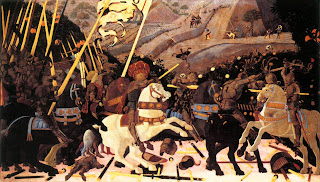 |
| The Battle of San Romano-Paolo Ucello |
The
Battle of San Romano by Paolo Uccello depicts the historic battle of 1432
between Florence and Siena. Within the
work one can see the Sienese ambushing the Florentine commander Niccolo da
Tolentino. Despite being outnumbered the Florentine army was able to maintain
the battle for around eight hours before being subdued.
Niccolo was a
condottiere (professional mercenary) and a close confident of the House of Medici.
It is also possible to identify Niccolo by the
red headdress and the Knot of Solomon on the banner. The red headdress is designed to keep the
viewer focused on the hero of the painting while allowing for better
perspective of the battle. Broken lances on the ground are an indication of
repeated battle and charges.
Solomon’s knot is of significance in this artwork. Looking
closely at the banner one is able to find this knot that is rightfully called
the Seal of Solomon. Christians, Muslims, and Jews all claim a heritage to the Seal
of Solomon with appropriate representations within their cultures. The seal represents wisdom and
knowledge. It has been seen as the all faith symbol that is used to
represent eternity.
The artist Paolo Uccello (1397 to 1475 was a
painter, author and mathematician. He painted many religious works of saints
and noble figures that made their way throughout the region. At one time he was employed by the House of Medici to create
fierce animals such as the lion fighting the venom serpent. Much of his time in
Florence was spent painting for churches and wealthy patrons using these
semi-religious symbolisms.
Paolo, as a mathematician, also focused on
illusions. His goal was to create the vanishing point where three dimensions
of space are depicted on a two dimension surfaces. It was part of his Pythagorean
ecstasy to use math within his pictures to create perspectives. One can find
this math in the arrangement of broken lances on the ground. All of the ground
pieces can be traced to their vanishing point.
The vanishing point is where everything comes together and gives a point
of reference to understand the mathematical curves in the rest of the painting.
No comments:
Post a Comment